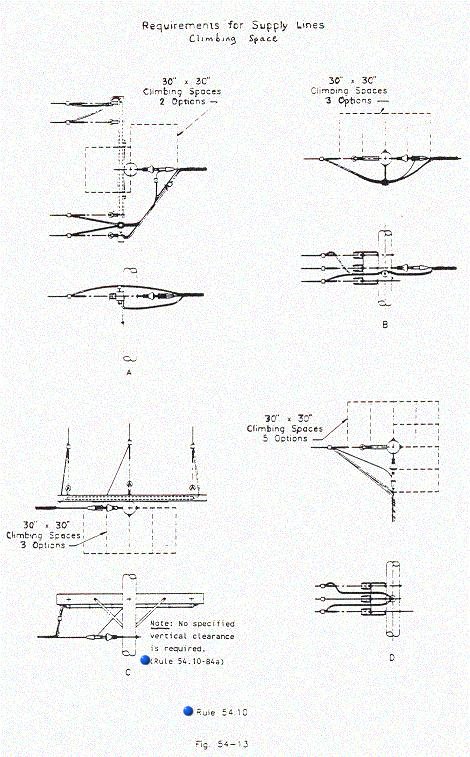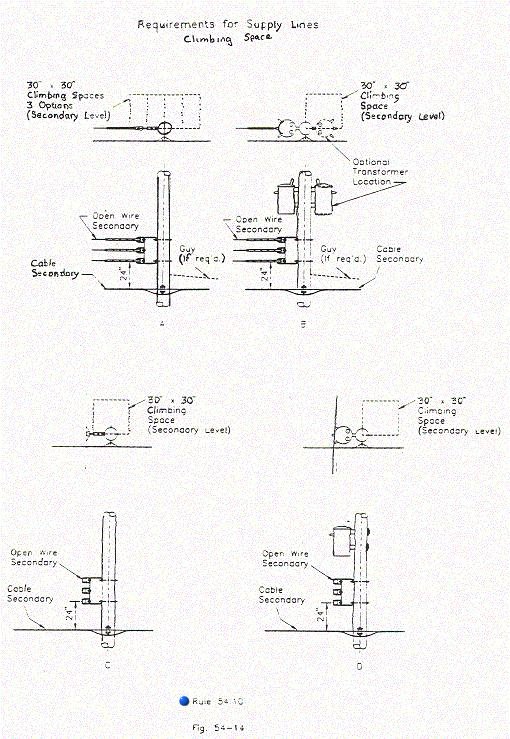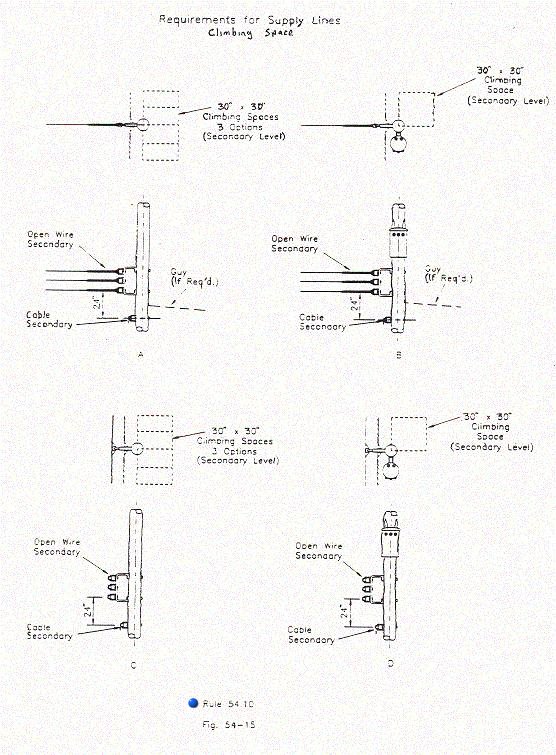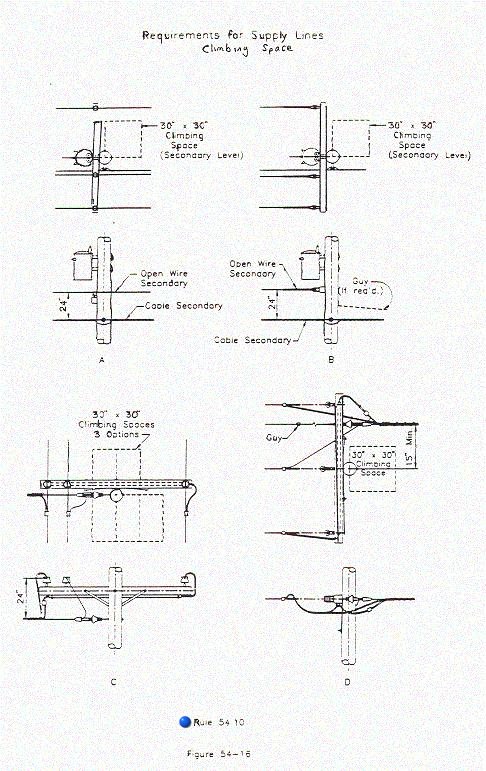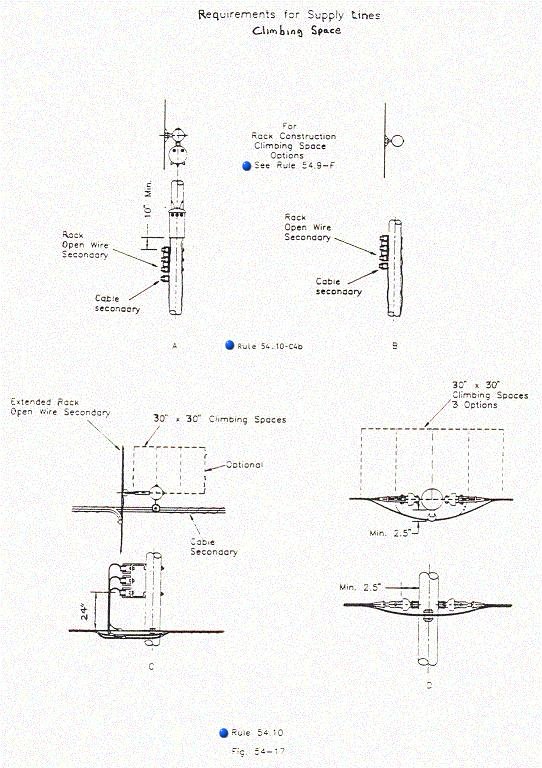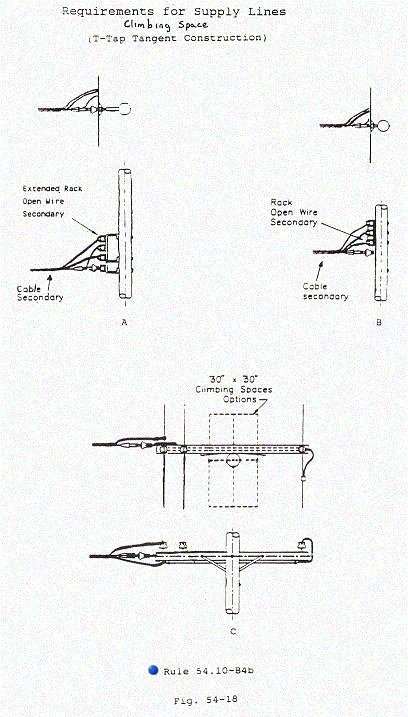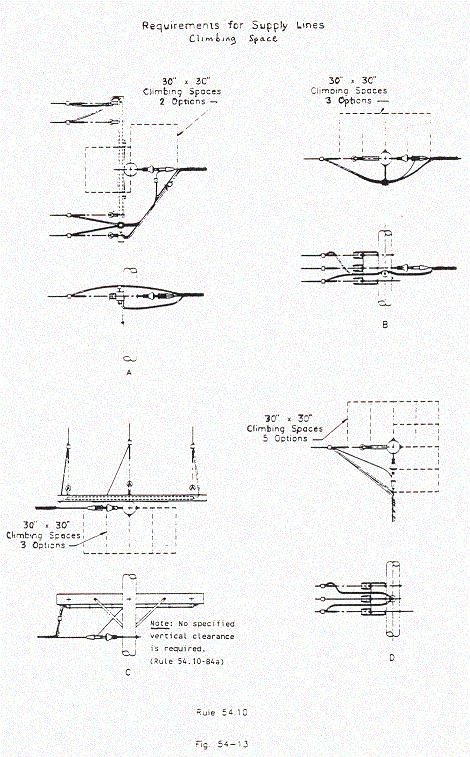
Original Version
Rule 54.10
54.10 Low Voltage multiconductor Cable With Bare Neutral, 0-750 Volts
A. General
The following rules cover requirements for 0-750 volt multiconductor cable having a bare neutral and are supplemental to the other rules of this order.
The term "messenger" as defined in Rule 21.11 of this order when used in Rule 54.10 of this order includes the bare neutral conductor whenever such conductor serves both as a conductor and also as a principal supporting member of the cable.
B. Pole Arrangement And Clearances
(1) Clearance From Poles: Multiconductor cables having a bare neutral may have clearances less than 15 inches from centerline and three inches from surface of pole, as specified in Table 1, Column D, Cases 8 and 9, respectively, but shall have a clearance of not less than 2 1/2 inches from the surface of pole and shall be supported on an insulator. Modifications of these basic clearances for conductors passing unattached are specified in Rule 54.10-B6.
(2) Clearance Between Conductors in Cables: No specified clearance is required between the insulated phase conductors and the bare neutral (see Rule 57.4-C).
(3) Conductor Arrangement: In parallel construction, cables shall not be attached to more than one side of a pole (there being four sides).
(4) At Cable Terminations: The clearances required by Rule 54.10-E of this order between a cable and unprotected line conductors shall not be held to apply between a cable (and its grounded messenger) and unprotected conductors of the same circuit on poles where unprotected conductors enter (or leave) a cable. On such poles no grounded messenger shall be less than 15 inches from centerline of pole.
(5) Deadend Construction: On poles with the messenger dead ended in more than one direction, the grounded messenger or insulated phase conductors of the cable shall not be attached to more than two three sides of the pole and shall be not less than 2 1/2 inches from the surface of the pole. On the climbing space side, service drops shall not be supported within 15 inches of the surface of the pole. The climbing space shall be determined by Rule 54.10-F3 of this order.
(6) From Non-climbable Street Lighting or Traffic Signal Poles or Standards: Multi-conductor cables passing (unattached) non-climbable street lighting and traffic signal poles or standards, including mastarms, brackets, and lighting fixtures may have a clearance less than the 36 inches specified in Table 1, Case 10, Column D, but shall have a clearance of not less than 15 inches, except when the conductors are mechanically protected from abrasion by materials specified in Rule 22.2. Such mechanical protection shall extend not less than 15 inches in each direction along the cable from centerline of pole, standard, attaching mastarms, or fixture; whether passing above, below or alongside. The conductors shall be installed in such a manner so as not to interfere with light distribution from lighting fixtures and shall not hamper workmen changing lamps or maintaining equipment.
C. Conductor Material And Strength
(1) Insulation: The phase conductors including jumper connections shall be covered with an insulation suitable for the voltage involved and shall conform with the standards established by the Insulated Power Cable Engineers Association, in Part 7, Section 7.3 of "Thermoplastic Insulated Wire and Cable for the Transmission and Distribution of Electrical Energy", Insulated Power Cable Engineers - Association Standard S-61-402, approved January 12, 1961, and National Electrical Manufacturers Association Standard WC5-1961, approved May 15, 1961.
(2) Messenger: Where cables are not maintained from a cable chair, the addition of the 200 pounds of vertical load specified in Rule 49.7-C may be reduced to 50 pounds to allow for the load imposed by workmen on ladders.
D. NOTE: Eliminated January 21, 1992, by Resolution SU-10.
E. Vertical Clearance between Conductor Levels
When attached to poles, or wood crossarms, at less than 15 inches from centerline of pole, bare neutral multiconductor cable shall be not less than 6 feet vertically above or 6 feet vertically below unprotected conductors, except as modified below:
(1) With Guard Arm Below Conductors of 0 –750 Volts: Where a guard arm is placed above bare neutral multiconductor cable in accordance with the provisions of Rule 57.7, the clearance of 6 feet may be reduced to not less than 4 feet below unprotected conductors of 0-750 volts.
(2) Above Conductors of 0 – 750 Volts More than 15 inches from center line of Pole: The vertical clearance between unprotected conductors of 0 –750 volts attached at more than 15 inches from the centerline of pole and bare neutral multiconductor cable above may be less than 6 feet but not less than 4 feet and no guard arm is required.
(3) Under a Transformer: No guard arm will be required over bare neutral multiconductor cable attached to the surface of a pole directly below a transformer installation provided that at the level all attachments to the pole shall be approximately in the vertical plane through the center lines of pole and transformer installation and no cable so attached makes angle greater than 60 degrees with the plane. The Such cable shall have a vertical clearance of not less than 48 inches below the level of conductors on the hanger arm; a vertical clearance not less than as specified in Rule 54.4–C6 below, the lowest point of the drip loop of primary leads to the transformer; and a vertical clearance not less than 10 Inches below the lowest part of the transformer case or hangers.
(4) Related Bare Neutral Multiconductor Cable and Crossarm: Where a bare neutral multiconductor cable is connected to conductors supported on a Crossarms on the same pole The vertical clearance between the levels of conductors of 0-750 volts on the crossarm and the bare neutral multiconductor cable shall not be less than 2 feet and climbing space shall be determined and maintained in the same quadrant or on the same side of pole through both conductor levels in accordance with climbing space requirements in Rules 54.7, and 54.10–F. This provision is not applicable where the crossarm is a combination arm.
F. Climbing Space
(1) Through Bare Neutral Multiconductor Cable Level: A climbing space shall be maintained through the level of conductors supported in bare neutral multiconductor cable construction and for a vertical distance of not less than 4 feet above and below such cable. The position of the climbing space through the levels of conductors in such cable construction shall be related to climbing space for conductor levels above and below the cable in accordance with Rules 54.7-A and 93. The depth of the climbing space shall be measured from the centerline of the pole.
(2) Dimensions: The dimensions of the climbing space shall be 30 inches square, and shall be provided on one side of the pole with the extremities of such width equidistant from the center line of the pole. On poles on which transformers or similar apparatus are pole bolted in line with primary conductors, a 30-inch square climbing space shall be provided in one quadrant or on one side of the pole.
(3) With Messenger Deadended and On Corner Poles: On poles with the messenger deadended and on corner poles, a 30-inch climbing space shall be provided in one quadrant or on one side of the pole suitably protected vertical runs or risers and ground wires attached to the surface of poles, and guys, are allowed in climbing spaces provided that no more than two guys (provided they are separated at the pole by a vertical distance of not more than 18 inches) or one vertical riser, run or ground wire are installed in any 4-foot vertical section of climbing space. The terminals or terminal fittings of risers or runs shall not be installed within climbing spaces.
G. Service Drops
Phase conductors of service drops taken from bare neutral multiconductor cables shall have insulation equivalent to that specified in Rule 54.10-C1. Where service drops are supported on ACSR or aluminum messenger, the messenger shall be protected against abrasion. Services supported on the messenger shall be attached not less than 15 inches from the surface of the pole.
H. Fastenings
In the application of Rule 57.5, where cables are not maintained from a cable chair, the addition of 200 pounds vertical load, specified in Rule 49.7-C may be reduced to 50 pounds to allow for the load imposed by workmen workers on ladders.
I. Extended Messenger
Messengers may be extended in bare neutral multiconductor cable construction provided the messenger is sectionalized as a guy.
J. Sags
In the application of Rule 57.9 the 200-pound additional vertical loading specified for a man and cable chair may be reduced to so pounds where the cable is not maintained from a cable chair.
Strikeout and Underline Version
Rule 54.10
54.10 Low Voltage multiconductor Cable With Bare Neutral, 0-750 Volts
A. General
The following
rules cover requirements for 0-750 volt bare neutral multiconductor
cable (when used as line conductor) having a bare neutral and are
supplemental to the other rules of this order.
The term
"messenger", as defined in Rule 21.11 of this order
when used in Rule 54.10, of this order includes the bare neutral
conductor whenever such conductor serves both as a conductor and also as a
principal supporting member of the cable.
The term
"unprotected conductors", used in Rule 54.10, means conductors as
defined in Rule 20.8-E.
The vertical
clearances from primary lead wires and drip loops to bare neutral
multiconductor cable shall be maintained as specified in Rule 54.4-C6.
B. Conductor Pole Arrangement
And Clearances
(1) Clearance From Poles: Bare Neutral M
multiconductor cables having a bare neutral may have clearances less
than 15 inches from. centerline and three 3 inches from surface
of pole, as specified in Table 1, Column D, Cases 8 and 9, respectively, but
shall have a clearance of not less than 2.5 2 ½ inches from the
surface of pole and shall be supported on an insulator. Modifications of these basic clearances for
conductors passing unattached are specified in Rule 54.10 B6
(2)(3)
Clearance Between Conductors
in Bare Neutral Multiconductor Cables: No specified clearance is
required between the insulated phase conductors and the bare neutral (see Rule 57.4-C).
The multiconductor cable shall be treated as a single conductor in the
application of other clearance requirements.
(3)
Conductor Arrangement: In parre, construction, cables shall not
be attached to more than one side of a pole (there being four sides).
(4)
Arrangement at Transitions from Bare Neutral Multiconductor
Cable to Other Types of Construction (e.q., Extended Rack. Rack or Crossarm):
At cable Terminations: The clearances required by rule 54.10-E of this
orderbetween a cable and uprotected line conductors shall not be held to apply
between a cable (and its grounded messenger) and unprotected conductors of the
same circuit on poles where unprotected conductors enter (or leave) a
cable. On such poles no grounded
messenger shall be less than 15 inches from centerline of the pole. The vertical clearance of 2 feet required by
Rule 54.10C4, between a cable and other unprotected line conductors shall not
be held to apply at locations where multiconductor cable terminates (ends), and
the cable transitions to other types of construction of: the same voltage
classification (0-750 Volts). The following vertical clearance requirements
shall apply:
a) Where those other conductors are terminated (ends), in another direction, no specified vertical clearance is required (See Fig. 54-13).
b) Where those other conductors are in tangent configuration (not terminated) and the type of construction is:
1) Extended Rack Construction: The minimum vertical clearance above or below unprotected conductors shall be 8 inches and the multiconductor cable shall have a minimum clearance of 15 inches from the centerline of pole. The multiconductor cable may be either terminated directly on an extended rack neutral position insulator or on its own individual insulator.
2) Rack Construction: The minimum vertical clearance above or below unprotected conductors shall be 10 inches. The multiconductor cable may be either terminated directly on a rack neutral position insulator or on its own individual insulator.
3) Crossarm Construction: The minimum vertical clearance above or below unprotected conductors shall be 2.feet. The multiconductor cable may be terminated on the end of a crossarm no specified vertical clearance is required (See Fiq 54-18).
The climbing space shal be determined and maintained in the same quadrant or on the same side of the pole in accordance with climbing space requirements in Rules 54.7, 54.9-F, 54.10-F or 54.12-F, whichever is related to the climbing space selected.
(5)
Arrangement for Deadend Construction: On poles with the
messenger dead ended in more than one direction, the grounded messenger or
insulated phase conductors of the multiconductor cable shall not be attached to
more than two three sides of the pole and shall be not be less
than 2.5 2 ½ inches from the surface of the pole. On the
climbing space side, service drops shall not be supported within 15 inches of
the surface of the pole. The climbing space shall be determined by Rule
54.10-F 3 of this order. (See Fig. 54-17).
(6)(2)
Clearance (Unattached) From Nonclimbable
Street Lighting or Traffic Signal Poles or Standards: Multi-conductor cables
passing (unattached) nonclimbable street lighting and traffic signal poles or
standards, including mastarms, brackets, and lighting fixtures may have a
clearance less than the 36 inches specified in Table 1, Case 10, Column D, but
shall have a clearance of not less than 15 inches, except when the
conductors are mechanically protected from abrasion by materials specified in
Rule 22.2. Such mechanical protection shall extend not less than 15 inches in
each direction along the cable from centerline of pole, standard, attaching
mastarms, or fixture; whether passing above, below or alongside. The conductors
shall be installed in such a manner so as not to interfere with light
distribution from lighting fixtures and shall not hamper workmen changing lamps
or maintaining equipment.
CE. Conductor Material And Strength
(1) Insulation: The phase conductors including jumper connections
shall be covered with an insulation suitable for the voltage involved and shall
conform with the requirements of Rule 20.8-G. standards established
by the Insulated Power Cable Engineers Association, in Part 7, Section 7.3 of
"Thermoplastic Insulated Wire and Cable for the Transmission and
Distribution of Electrical Energy", Insulated Power Cable Engineers -
Association Standard S-61-402, approved January 12, 1961, and National
Electrical Manufacturers Association Standard WC5-1961, approved May 15, 1961.
(2) Messenger: Where multiconductor cables are not maintained
by workers from using a cable chair, the additional
allowance of the 200 pounds of vertical load specified in Rule 49.7-CB
may be reduced to 50 pounds to allow for the load imposed by workmen workers
on ladders.
D.
NOTE: Eliminated January 21, 1992, by Resolution SU-10.
EC. Vertical Clearance between Conductor Levels
When attached
to poles, or wood crossarms, or other supports at less than 15
inches from centerline of pole, bare neutral multiconductor cable shall be not
be
less than 6 feet vertically above or 6 feet vertically below unprotected
conductors, except as modified below:
(1) With
Guard Arm Below Conductors of 0 –750 Volts Placed above Cable:
Where a guard arm is placed above bare neutral multiconductor cable in
accordance with the provisions of Rule 57.7, the vertical clearance of 6
feet may be reduced to not less than 4 feet below unprotected conductors of 0-750
750 - 22,500 volts.
(2) Cable Attached 15 Inches or More from Center Line of Pole: When bare neutral multiconductor cable is attached (or supported) 15 inches or more from the center line of pole, the vertical clearance of 6 feet may be reduced to not less than 4 feet below unprotected conductors of 750 - 22,500 volts. When the vertical clearance is reduced to less than 6 feet, all portions of service drops attached at that level shall be 15 inches or more from the centerline of pole.
(2) Above
Conductors of 0 – 750 Volts More than 15 inches from center line of Pole: The vertical clearance between unprotected
conductors of 0 –750 volts attached at more than 15 inches from the centerline
of pole and bare neutral multiconductor cable above may be less than 6 feet but
not less than 4 feet and no guard arm is required.
(3) Cable
Deadended Under a Transformer: No guard arm will be required over bare
neutral multiconductor cable attached to deadended on the surface
of a pole directly below a transformer installation. provided that at
the level all attachments to the pole shall be approximately in the vertical
plane through the center lines of pole and transformer installation and no
cable so attached makes angle greater than 60 degrees with the plane. The Such cable shall have a vertical
clearance of not less than:
a) 48
inches 4 Feet below the level of unprotected line conductors on
the hanger arm; and
b) a
vertical clearance not less than Aas specified in Rule
54.4–C6 below, the lowest point of the drip loop of primary leads to the
transformer(s); and
c) a
vertical clearance not less than 10 Inches below the lowest part of the
transformer case(s) or hangers(s).
(4) Related
Bare Neutral Multiconductor Cable and Crossarm above and below
Other Types of Construction of the Same 0 - 750 Voltage
Classification: Where a bare neutral multiconductor cable is connected
to conductors supported on the same pole above or below another
conductor level of the same voltage classification that is supported on:
a) Crossarms
or Extended Racks: on the same pole The vertical clearance
between the these levels of conductors of 0-750 volts on the
crossarm and the bare neutral multiconductor cable shall not be less than 2
feet and no guard arm is required (see Figures 54–14 through 54–17); or on
b) Racks
(Rule 54.9): The vertical clearance between these levels of conductors shall
not be less than 10 inches for spans not exceeding 200 feet and 12 inches for
spans in excess of 200 feet and no guard arm is required.
The climbing
space shall be determined and maintained in the same quadrant or on the same side
of pole through both conductor levels in accordance with climbing space
requirements in Rules 54.7, and 54.10–F, or 54.12–F, whichever rule
is related to the climbing space selected (see Figures 54–13 through 54–18).
EXCEPTION: When rack construction is present, the more stringent climbing space requirements of Rule 54.9–F shall always be maintained through both levels.
This provision (Rule 54.10–C4) is not applicable where the crossarm is a combination arm.
(5) Multiple
Related Bare Neutral Multiconductor Cables: Where multiple bare neutral
multiconductor cables having the same secondary voltage source (related) are
supported on the same pole, no specified clearance between such cables is
required.
The
climbing space shall be maintained in accordance with climbing space
requirements in Rule 54.10–F.
(6) Multiple
Unrelated Bare Neutral Multiconductor Cables: Where multiple bare neutral
multiconductor cables not having the same secondary voltage source (unrelated)
but are of the same voltage classification of 0 - 750 volts, and are supported
on the same pole, no specified vertical clearance between such levels is
required. However, each multiconductor cable shall be supported on a separate
attachment (rack, spool, deadend clevis, etc.)
The
climbing space shall be maintained in accordance with climbing space
requirements in Rule 54.10–F.
F. Climbing Space
(1)
Through Bare Neutral Multiconductor Cable Level: A climbing
space shall be maintained through the level of conductors supported in bare
neutral multiconductor cable construction. and Said climbing
space shall be maintained for a vertical distance of not less than 4 feet
above and below such cable. The
position of the climbing space through the levels of conductors in such cable
construction shall be related to ~ climbing space for conductor levels above
and below the cable in accordance with Rules 54.7-A and 93. The depth of the climbing space shall be
measured from the centerline of the pole.Where multiconductor cable is installed at pole top, the
climbing space shall extend UP to the level of such cable and need not be
provided through and above such level.
(2)
Dimensions: The dimensions of the climbing space shall be 30
inches square, and shall be provided in one quadrant or on one side of
the pole. The depth of the climbing space shall be measured
from the centerline of the pole (see Figures 54–13 through 54–18). with the extremities of such
width equidistant from the center line of the pole. On poles on which
transformers or similar apparatus are pole bolted in line with primary
conductors, a 30-inch square climbing space shall be provided in one quadrant
or on one side of the pole.
(3)
Allowable Climbing Space Obstructions: With Messenger Deadended and On Corner
Poles: On poles with the messenger deadended and on corner poles, a 30-inch
climbing space shall be provided in one quadrant or on one side of the pole
suitably protected vertical runs or risers and ground wires attached to the
surface of poles, and guys, are allowed in climbing spaces provided that no
more than two guys (provided they are separated at the pole by a vertical
distance of not more than 18 inches) or one vertical riser, run or ground wire
are installed in any 4-foot vertical section of climbing space. The terminals
or terminal fittings of risers or runs shall not be installed within climbing
spaces.Allowable climbing space obstructions
are:
a) Guys. However, not more than two guys having a vertical separation of 18 inches or less can be installed in any 4-foot section of climbing space.
b) Suitably protected (covered only by wood, see Rule 22.2):
1) Vertical risers; or
2) Vertical runs; or
3) Ground wires.
Such risers runs and grounds are allowable provided that not more than one is installed in any 4-foot section of climbing space.
c) Insulators and their attaching brackets may extend one-half their diameter into the climbing space.
d) Conductors may extend one-half their diameter into the climbing space.
e) Street light brackets may extend one-half their diameter into climbing space. Associated street light bracket struts are allowed in climbing space.
f) Operating rods (e.g., switch rods) and their associated hardware may extend one-half their diameter into climbing space
g) Bands, limited to 6 inches in width with no more than one band allowed in an 24-inch section of climbing space these limitations are excluded for pole stubbing and pole splicing bands when pole step provisions are installed.
h) Bolts and their washers.
The terminals or terminal fittings of risers or runs shall not be installed within climbing spaces.
GD. Service Drops
Phase conductors of all service drops taken from bare
neutral multiconductor cables shall have insulation equivalent to that
specified in Rule 54.10-Cl. Rule
54.10-E1.
Where service drops are supported on ACSR or aluminum a
multiconductor cable’s bare neutral messenger, the attachment to the
messenger shall be protected against an abrasion resistant
connection. Services supported
on the messenger shall be attached not less than 15 inches from the surface of
the pole.
H. Fastenings
Hardware used in connection with messengers
shall meet the strength requirement of Rule 49.7–C. Deadend attachments used on
messengers shall have a strength not less than that of the messenger. In
the application of Rule 57.5, w Where cables are not maintained by workers
using a cable chair from, the additional allowance of 200 pounds vertical
load, specified in Rule 49.7–C may be reduced to 50 pounds to allow for
the load imposed by workmen workers on ladders.
I.
Extended Messenger
Messengers
may be extended in bare neutral multiconductor cable construction provided the
messenger is sectionalized as a guy.
JG. Sags
The sags of messengers which
support multiconductor cable shall be such that under the maximum loading
conditions, the tensions in the messengers shall not exceed the safe working
stresses specified in Rule 49.7–B. In
the application of Rule 57.9 Where the multiconductor cables are not
maintained by workers using a cable chair, the 200 pound additional allowance
for vertical loading specified in Rule 49.7–B for a man and cable
chair may be reduced to 50 pounds to allow for the load imposed by
workers on ladders. where the cable is not maintained from a cable
chair.

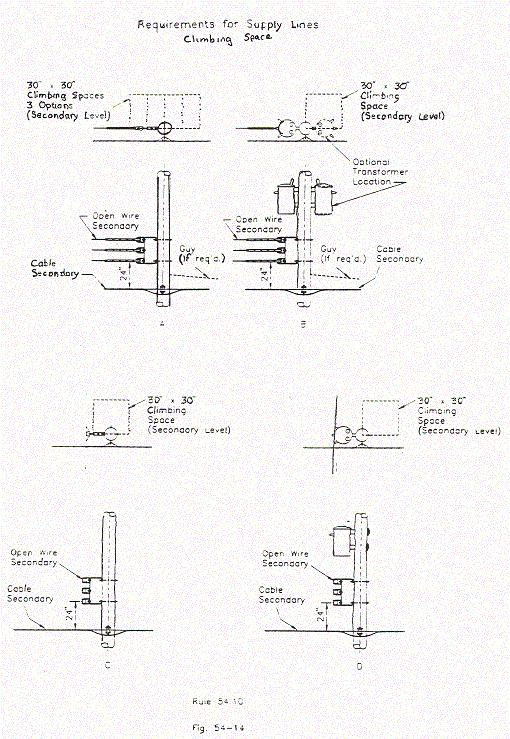
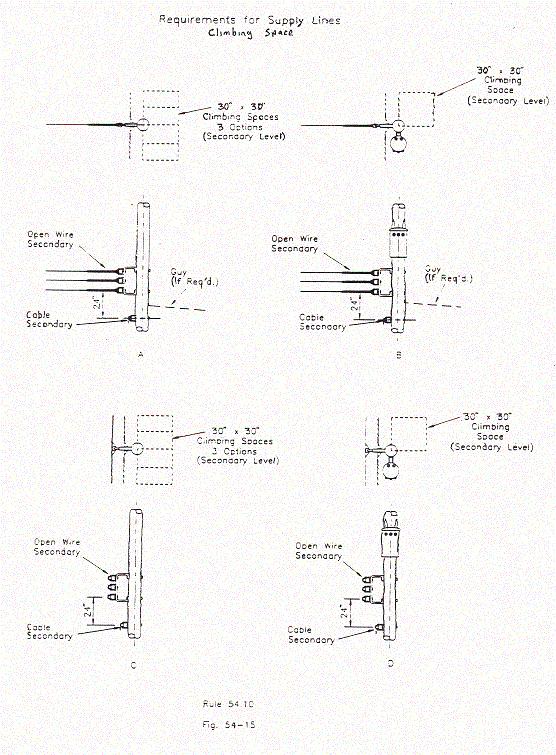
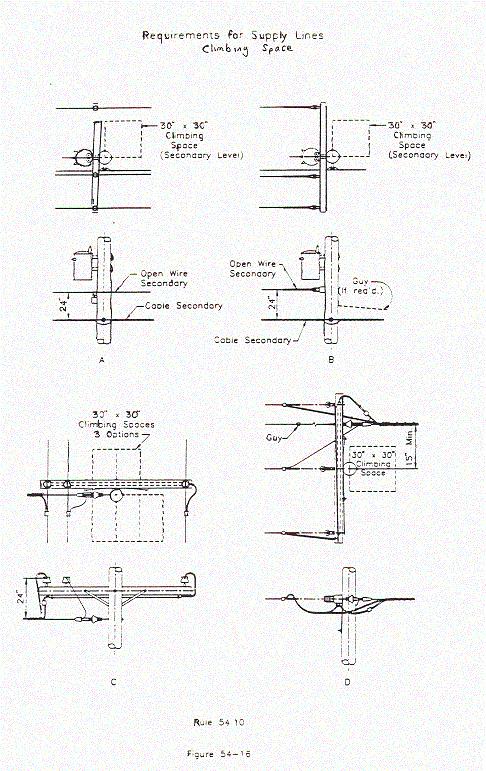
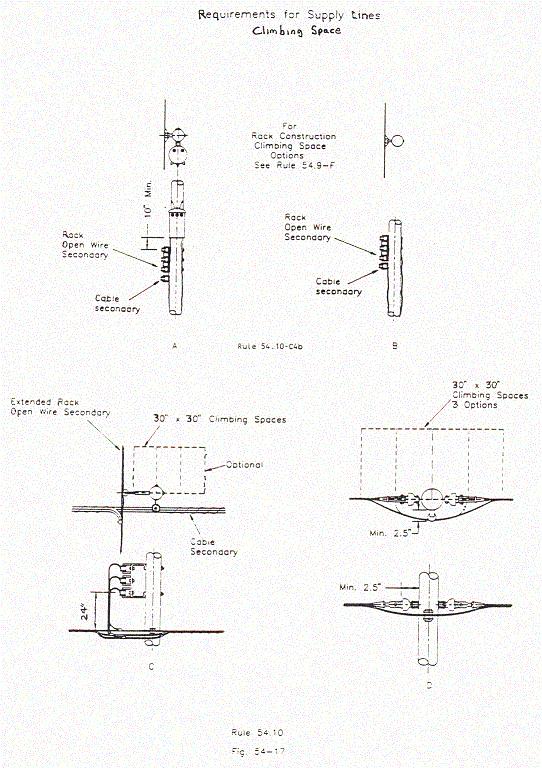
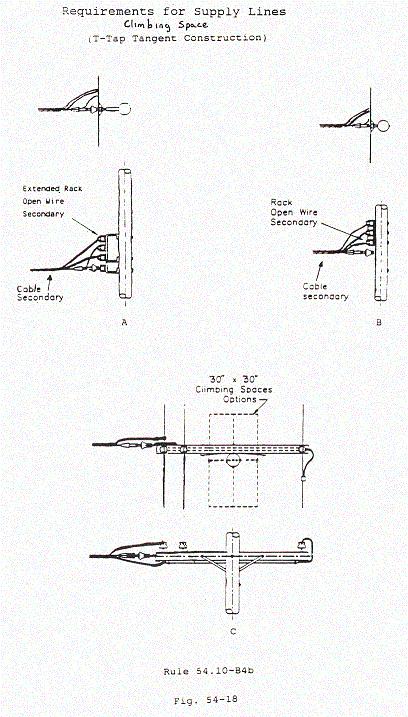
Final Version
Rule 54.10
54.10 Low Voltage multiconductor Cable With Bare Neutral, 0-750 Volts
A. General
The
following rules cover requirements for 0-750 volt bare neutral multiconductor
cable (when used as line conductor) and are supplemental to the other rules of
this order.
The
term “messenger”, as defined in Rule 21.11 when used in Rule 54.10, includes
the bare neutral conductor whenever such conductor serves both as a conductor
and also as a principal supporting member of the cable.
The
term “unprotected conductors”, used in Rule 54.10, means conductors as defined
in Rule 20.8–E.
The
vertical clearances from primary lead wires and drip loops to bare neutral
multiconductor cable shall be maintained as specified in Rule 54.4–C6.
B. Conductor Arrangement and Clearances
(1) Clearance from Poles: Bare neutral multiconductor cables may have clearances less than 15 inches from centerline and 3 inches from surface of pole, as specified in Table 1, Column D, Cases 8 and 9, respectively, but shall have a clearance of not less than 2.5 inches from the surface of pole and shall be supported on an insulator.
(2) Clearance (Unattached) from Nonclimbable Street Lighting or Traffic Signal Poles or Standards: Multiconductor cables passing (unattached) nonclimbable street lighting and traffic signal poles or standards, including mastarms, brackets, and lighting fixtures may have a clearance less than 36 inches as specified in Table 1, Case 10, Column D, when the conductors are mechanically protected from abrasion by materials specified in Rule 22.2. Such mechanical protection shall extend not less than 15 inches in each direction along the cable from centerline of pole, standard, attaching mastarm or fixture whether passing above, below or alongside. The conductors shall be installed in such a manner so as not to interfere with light distribution from lighting fixtures and shall not hamper workmen changing lamps or maintaining equipment.
(3) Clearance between Conductors in Bare Neutral Multiconductor Cables: No specified clearance is required between the insulated phase conductors and the bare neutral (see Rule 57.4–C). The multiconductor cable shall be treated as a single conductor in the application of other clearance requirements.
(4) Arrangement at Transitions from Bare Neutral Multiconductor Cable to Other Types of Construction (e.g., Extended Rack, Rack or Crossarm): The vertical clearance of 2 feet required by Rule 54.10–C4, between a cable and other unprotected line conductors, shall not be held to apply at locations where multiconductor cable terminates (ends) and the cable transitions to other types of construction of the same voltage classification (0 - 750 volts). The following vertical clearance requirements shall apply:
a) Where those other conductors are terminated (end) in another direction, no specified vertical clearance is required (see Figure 54–13).
b) Where those other conductors are in tangent configuration (not terminated) and the type of construction is:
1) Extended Rack Construction: The minimum vertical clearance above or below unprotected conductors shall be 8 inches and the multiconductor cable shall have a minimum clearance of 15 inches from the centerline of pole. The multiconductor cable may be either terminated directly on an extended rack neutral position insulator or on its own individual insulator.
2) Rack Construction: The minimum vertical clearance above or below unprotected conductors shall be 10 inches. The multiconductor cable may be either terminated directly on a rack neutral position insulator or on its own individual insulator.
3) Crossarm Construction: The minimum vertical clearance above or below unprotected conductors shall be 2 feet. The multiconductor cable may be terminated on the end of a crossarm and no specified vertical clearance is required (see Figure 54–18).
The climbing space shall be determined and maintained in the same quadrant or on the same side of the pole in accordance with climbing space requirements in Rules 54.7, 54.9–F, 54.10–F or 54.12–F, whichever is related to the climbing space selected.
(5) Arrangement for Deadend Construction: On poles with the messenger deadended in more than one direction, the grounded messenger or insulated phase conductors of the multiconductor cable shall not be attached to more than two sides of the pole and shall not be less than 2.5 inches from the surface of the pole. The climbing space shall be determined by Rule 54.10–F. (see Figure 54–17).
C. Vertical Clearance between Conductor Levels
When attached to poles, crossarms, or other supports at less than 15 inches from centerline of pole, bare neutral multiconductor cable shall be not less than 6 feet vertically above or 6 feet vertically below unprotected conductors, except as modified below:
(1) With Guard Arm Placed above Cable: Where a guard arm is placed above bare neutral multiconductor cable in accordance with the provisions of Rule 57.7, the vertical clearance of 6 feet may be reduced to not less than 4 feet below unprotected conductors of 750 - 22,500 volts.
(2) Cable Attached 15 Inches or More from Center Line of Pole: When bare neutral multiconductor cable is attached (or supported) 15 inches or more from the center line of pole, the vertical clearance of 6 feet may be reduced to not less than 4 feet below unprotected conductors of 750 - 22,500 volts. When the vertical clearance is reduced to less than 6 feet, all portions of service drops attached at that level shall be 15 inches or more from the centerline of pole.
(3) Cable Deadended under a Transformer: No guard arm will be required over bare neutral multiconductor cable deadended on the surface of a pole directly below a transformer installation. Such cable shall have a vertical clearance of not less than:
a) 4 Feet below unprotected line conductors; and
b) As specified in Rule 54.4–C6 below, the lowest point of the drip loop of primary leads to the transformer(s); and
c) 10 Inches below the lowest part of the transformer case(s) or hangers(s).
(4) Cable above and below Other Types of Construction of the Same 0 - 750 Voltage Classification: Where a bare neutral multiconductor cable is supported on the same pole above or below another conductor level of the same voltage classification that is supported on:
a) Crossarms or Extended Racks: The vertical clearance between these levels of conductors shall not be less than 2 feet and no guard arm is required (see Figures 54–14 , 54-15, 54-16 and 54–17); or on
b) Racks
(Rule 54.9): The vertical clearance between these levels of conductors shall
not be less than 10 inches for spans not exceeding 200 feet and 12 inches for
spans in excess of 200 feet and no guard arm is required.
The climbing space shall be determined
and maintained in the same quadrant or on the same side of pole through both
conductor levels in accordance with climbing space requirements in Rules 54.7,
54.10–F, or 54.12–F, whichever rule is related to the climbing space selected
(see Figures 54–13,
54–14
, 54-15,
54-16,
54–17 and 54–18).
EXCEPTION:
When rack
construction is present, the more stringent climbing space requirements of Rule
54.9–F shall always be maintained through both levels.
This
provision (Rule 54.10–C4) is not applicable where the crossarm is a combination
arm.
(5) Multiple
Related Bare Neutral Multiconductor Cables: Where multiple bare neutral
multiconductor cables having the same secondary voltage source (related) are
supported on the same pole, no specified clearance between such cables is
required.
The
climbing space shall be maintained in accordance with climbing space
requirements in Rule 54.10–F.
(6) Multiple
Unrelated Bare Neutral Multiconductor Cables: Where multiple bare neutral
multiconductor cables not having the same secondary voltage source (unrelated)
but are of the same voltage classification of 0 - 750 volts, and are supported
on the same pole, no specified vertical clearance between such levels is
required. However, each multiconductor cable shall be supported on a separate
attachment (rack, spool, deadend clevis, etc.)
The
climbing space shall be maintained in accordance with climbing space
requirements in Rule 54.10–F.
D. Service Drops
Phase conductors of all service drops taken from bare neutral multiconductor cables shall have insulation equivalent to that specified in Rule 54.10–E1.
Where service drops are supported on a multiconductor cable’s bare neutral messenger, the attachment to the messenger shall be an abrasion–resistant connection.
E. Conductor Material and Strength
(1) Insulation: The phase conductors, including jumper connections, shall be covered with an insulation suitable for the voltage involved and shall conform with the requirements of Rule 20.8–G.
(2) Messenger: Where multiconductor cables are not maintained by workers using a cable chair, the additional allowance of the 200 pounds of vertical load specified in Rule 49.7–B may be reduced to 50 pounds to allow for the load imposed by workers on ladders.
F. Climbing Space
(1) Through
Bare Neutral Multiconductor Cable Level: A climbing space shall be
maintained through the level of conductors supported in bare neutral
multiconductor cable construction. Said climbing space shall be maintained for
a vertical distance of not less than 4 feet above and below such cable. The
position of the climbing space through the levels of conductors in such cable
construction shall be related to the climbing space for conductor levels above
and below the cable in accordance with Rules 54.7–A and 93.
Where
multiconductor cable is installed at pole top, the climbing space shall extend
up to the next level of such cable and need not be provided through and above
such level.
(2) Dimensions: The dimensions of the climbing space shall be 30 inches square, and shall be provided in one quadrant or on one side of the pole. The depth of the climbing space shall be measured from the centerline of the pole (see Figures 54–13, 54–14 , 54-15, 54-16, 54–17 and 54–18).
(3) Allowable Climbing Space Obstructions: Allowable climbing space obstructions are:
a) Guys. However, not more than two guys having a vertical separation of 18 inches or less can be installed in any 4–foot section of climbing space.
b) Suitably protected (covered only by wood, see Rule 22.2):
1) Vertical risers; or
2) Vertical runs; or
3) Ground wires.
Such risers, runs and grounds are allowable provided that not more than one is installed in any 4–foot section of climbing space.
c) Insulators and their attaching brackets may extend one–half their diameter into the climbing space.
d) Conductors may extend one–half their diameter into the climbing space.
e) Street light brackets may extend one–half their diameter into climbing space. Associated street light bracket struts are allowed in climbing space.
f) Operating rods (e.g., switch rods) and their associated hardware may extend one–half their diameter into climbing space.
g) Bands, limited to 6 inches in width with no more than one band allowed in any 24–inch section of climbing space (these limitations are excluded for pole stubbing and pole splicing bands when pole step provisions are installed.)
h) Bolts and their washers.
The terminals or terminal fittings of risers or runs shall not be installed within climbing space.
G. Sags
The sags of messengers which support multiconductor cable shall be such that under the maximum loading conditions, the tensions in the messengers shall not exceed the safe working stresses specified in Rule 49.7–B. Where the multiconductor cables are not maintained by workers using a cable chair, the 200 pound additional allowance for vertical loading specified in Rule 49.7–B may be reduced to 50 pounds to allow for the load imposed by workers on ladders.
H. Fastenings
Hardware used in connection with messengers shall meet the strength requirement of Rule 49.7–C. Deadend attachments used on messengers shall have a strength not less than that of the messenger. Where cables are not maintained by workers using a cable chair, the additional allowance of 200 pounds vertical load specified in Rule 49.7–C may be reduced to 50 pounds to allow for the load imposed by workers on ladders.
I. Rule 54.10-I Deleted
J. Rule 54.10-J Deleted (See Rule 54.10-G)
